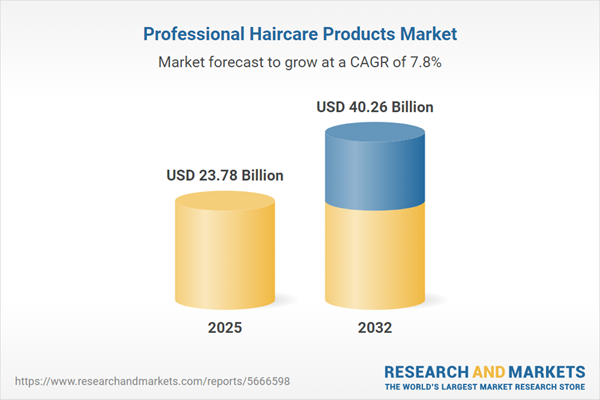Speak directly to the analyst to clarify any post sales queries you may have.
The professional haircare products market continues to evolve rapidly, driven by sustainability, digital transformation, and shifting client expectations. Senior decision-makers must navigate complex dynamics to secure growth, strategic differentiation, and lasting supply resilience across global regions.
Market Snapshot: Professional Haircare Products Market Trends and Dynamics
The global professional haircare products market attained a value of USD 22.02 billion in 2024 and is expected to grow to USD 23.78 billion by 2025, with long-term forecasts projecting an expansion to USD 40.26 billion by 2032. This growth is propelled by heightened demand for premium, eco-friendly haircare formulations and continued investment in fortifying supply chain resilience. As industry leaders and newcomers pursue new channels and territories, the integration of digital and traditional distribution is enhancing market access and professional engagement worldwide.
Scope & Segmentation of the Professional Haircare Products Market
This report delivers actionable segmentation, offering practical guidance for leadership in setting strategies, allocating resources, and tailoring responses to regional dynamics within the professional haircare products market. Segment analysis covers:
- Product Types: Conditioner; permanent color; semi-permanent color; temporary dye; shampoo; styling agents including gels, mousse, spray, wax; and specialty treatments such as keratin, protein, and scalp care items. These categories reflect a diverse range of professional solutions used across both salons and home care channels.
- Ingredient Segments: Dermatologically tested products, natural extract-based items, paraben-free, and sulfate-free offerings. Clear labeling and a focus on product safety are driving transparency and trust, responding to both stylist and end-user requirements.
- Distribution Channels: Beauty supply distributors, direct-to-salon models, company-owned e-commerce, third-party platforms, and wholesale networks. Each channel represents unique purchasing behaviors and regional preferences for professional haircare products.
- Application Modes: In-salon professional applications, as well as solutions tailored for at-home professional care standards. The broadened application spectrum extends reach and reinforces the value offered beyond traditional salon settings.
- Regional Coverage: North America, Latin America, Europe, Middle East & Africa, and Asia-Pacific. This includes regional insights focused on key markets such as the United States, Germany, China, and Japan to inform highly localized strategies and address varying market maturity levels.
Leading manufacturers, including L'Oréal S.A., Coty Inc., The Procter & Gamble Company, Unilever PLC, Henkel AG & Co. KGaA, Kao Corporation, Revlon, Davines, Amorepacific Corporation, and John Paul Mitchell Systems, LLC, are optimizing compliance structures, digital capabilities, and stakeholder engagement as they advance adaptive approaches to emerging demands.
Key Takeaways for Senior Decision-Makers
- Digital platforms and analytics drive personalized engagement, enabling brands and salons to deliver differentiated client experiences and to optimize business operations.
- Sustainability initiatives, such as ethical ingredient sourcing and environmentally responsible packaging, bolster reputational trust and help ensure compliance with evolving regulations.
- Technology, including virtual consultations and augmented reality, expands client offerings by bridging in-salon and at-home services, building new revenue streams.
- Continuous research and agile product development support rapid market adaptation, aligning professional inventories with changing consumer and salon requirements.
- Diversification across procurement and supply chain partners increases resilience and can insulate organizations from unexpected market disruptions.
- End-to-end digital integration strengthens agility, supporting proactive, data-informed decision-making and deeper ongoing relationships across the market’s varied segments.
Tariff Impact: Navigating U.S. 2025 Changes in the Professional Haircare Products Market
With new U.S. tariffs set for 2025, industry stakeholders are adapting strategies to address cost pressures and supply chain unpredictability. Companies respond by enhancing domestic sourcing, broadening supplier bases, and updating their distribution frameworks. Proactive supplier engagement and streamlined operations are proving critical for maintaining consistent service levels and safeguarding pricing structures within a shifting regulatory context.
Methodology & Data Sources
The research process for this report includes direct interviews with key industry players, such as salon operators, suppliers, and distribution organizations. A thorough secondary literature review and validation by a dedicated subject matter expert panel ensures the findings are relevant and actionable for executives.
Why This Report Matters
- Enables operational optimization and effective strategy development in a dynamic professional haircare products landscape.
- Provides actionable recommendations for procurement and commercial leaders navigating regulatory and market shifts.
- Supports risk management, sustainability efforts, and long-term market positioning for senior decision-makers seeking to stay ahead of evolving client needs.
Conclusion
Senior leaders will gain a strategic advantage by leveraging this report to support sustainable growth, ensure supply chain robustness, and maintain market leadership in the professional haircare products sector.
Additional Product Information:
- Purchase of this report includes 1 year online access with quarterly updates.
- This report can be updated on request. Please contact our Customer Experience team using the Ask a Question widget on our website.
Table of Contents
3. Executive Summary
4. Market Overview
7. Cumulative Impact of Artificial Intelligence 2025
Companies Mentioned
The companies profiled in this Professional Haircare Products market report include:- L'Oréal S.A.
- Coty Inc.
- The Procter & Gamble Company
- Unilever PLC
- Henkel AG & Co. KGaA
- Kao Corporation
- Revlon, Inc.
- Davines S.r.l.
- Amorepacific Corporation
- John Paul Mitchell Systems, LLC
Table Information
| Report Attribute | Details |
|---|---|
| No. of Pages | 181 |
| Published | October 2025 |
| Forecast Period | 2025 - 2032 |
| Estimated Market Value ( USD | $ 23.78 Billion |
| Forecasted Market Value ( USD | $ 40.26 Billion |
| Compound Annual Growth Rate | 7.8% |
| Regions Covered | Global |
| No. of Companies Mentioned | 11 |









